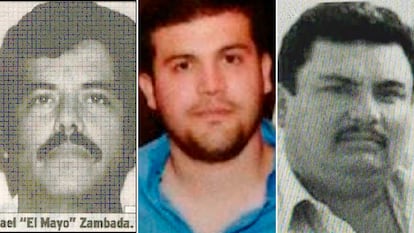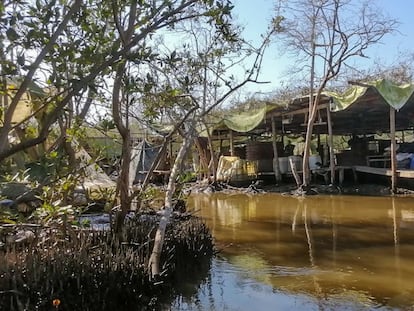Sinaloa Cartel: Four factions share the business of trafficking fentanyl and methamphetamines to the US
Founded in the 1980s, the criminal organization is struggling amid the raids launched by the authorities and an internal turf war

The arrest of Ismael El Mayo Zambada, the Boss of Bosses, represents a huge blow to the Sinaloa Cartel. The criminal organization, one of Mexico’s biggest, has been resisting the manhunt by the United States in its war against fentanyl trafficking, as well as an internal war for territorial control. The siege by the authorities bore fruit and ended this Thursday with the arrest of one of the most powerful drug traffickers in the country, who had never once set foot in prison. Founded in the 1980s in the mountains of the Pacific State, this cartel is divided into four factions that share the drug trafficking pie: one faction is led precisely by El Mayo, and it has now been orphaned; another one is headed by Los Chapitos, the sons of Joaquín El Chapo Guzmán Loera; a third is commanded by Aureliano El Guano Guzmán; and the last one is currently managed by relatives of Rafael Caro Quintero, who was arrested in 2022 in northern Mexico.
Since El Chapo’s third and final capture in 2016, the Pacific Cartel has accumulated pursuits and arrests. Even as it resists the advance of the authorities, it disputes control of Mexican territory with rival organizations, leaving a trail of bloodshed throughout the country. The latest annual report of the Drug Enforcement Administration (DEA) in May portrayed the criminal structure created by El Chapo, El Mayo and a group of drug traffickers. “It does not have a leader,” said the anti-drug agency. Rather, it is the union of these four factions, which the report assures are independent but cooperate with each other. At least this is the picture painted after El Chapo’s conviction in 2019.
“This structure theoretically gives the heads of the independent drug trafficking groups the ability to share resources – like smuggling routes, corrupt contacts, access to illicit chemical suppliers and money laundering networks – without sharing profits or having to answer to a main chain of command,” the DEA described in its report. The Los Chapitos faction was led by Iván Guzmán Salazar, Alfredo Guzmán Salazar, Joaquín Guzmán López, and Ovidio Guzmán López. But the last two are currently in custody. The first was captured this Thursday along with El Mayo, and the second in a Mexican Army operation in January 2023. Washington accuses all of them of possession of drugs with intent to distribute them, conspiracy to import, manufacture, and distribute drugs, conspiracy to launder money, carrying weapons, and being members of a criminal enterprise.
The El Mayo faction, perhaps the most powerful in Culiacán (capital of Sinaloa), had kept the same leader for three decades, but he was already in poor health. The capo was accused of fentanyl trafficking by a New York court in February 2024. The third cell was controlled by Aureliano Guzmán Loera, El Chapo’s brother, who controls part of the so-called Golden Triangle. Earlier this month, Mexican authorities arrested a man who operated as El Guano’s security chief in a town in the state of Durango. The local press then reported that the capo, for whom the Joe Biden government is offering a reward of $5 million, managed to escape from the military through the mountains. The United States accuses him of trafficking heroin, cocaine, fentanyl, methamphetamine and marijuana.
The fourth faction, known as the Caborca Cartel, was led by Rafael Caro Quintero, a former ally of the organization’s founders. The man who was called El Narco de Narcos in the 1980s was captured in July 2022. Since his arrest, the United States has pushed for his extradition in order to to put him on trial, but the transfer has remained on hold due to a series of injunctions. Beyond some collaboration between the cells, the DEA points out that “internal power struggles and fluctuating alliances leave the viability of the ‘umbrella model’ in question.”
The war against fentanyl has become a priority for the U.S. authorities, who have stepped on the accelerator against the organization, accused of being, together with the Jalisco Nueva Generación Cartel, chiefly responsible for illegal fentanyl trafficking. The DEA said that “together, the Sinaloa and Jalisco cartels have caused the worst drug crisis in U.S. history.” In their pursuit, they have tried to cover all possible actors. Other arrests that hit the structure include Dámaso López, a former collaborator, and Néstor Isidro El Nini Pérez Salas, head of security for Los Chapitos. As is customary in these criminal organizations, each arrest is followed by a restructuring, and the scenario is rewritten after each new blow.
Sign up for our weekly newsletter to get more English-language news coverage from EL PAÍS USA Edition
Tu suscripción se está usando en otro dispositivo
¿Quieres añadir otro usuario a tu suscripción?
Si continúas leyendo en este dispositivo, no se podrá leer en el otro.
FlechaTu suscripción se está usando en otro dispositivo y solo puedes acceder a EL PAÍS desde un dispositivo a la vez.
Si quieres compartir tu cuenta, cambia tu suscripción a la modalidad Premium, así podrás añadir otro usuario. Cada uno accederá con su propia cuenta de email, lo que os permitirá personalizar vuestra experiencia en EL PAÍS.
¿Tienes una suscripción de empresa? Accede aquí para contratar más cuentas.
En el caso de no saber quién está usando tu cuenta, te recomendamos cambiar tu contraseña aquí.
Si decides continuar compartiendo tu cuenta, este mensaje se mostrará en tu dispositivo y en el de la otra persona que está usando tu cuenta de forma indefinida, afectando a tu experiencia de lectura. Puedes consultar aquí los términos y condiciones de la suscripción digital.
More information

Mexico’s mangroves: From protectors of sea life to narco-hideouts
Archived In
Últimas noticias
All the effects of gentrification in one corner of Mexico’s Colonia Roma
Palestinian reporter Youmna El Sayed: ‘My family told me I had to choose between being a journalist or a mother’
Russell Tovey: ‘I was advised many times not to come out, I don’t think there was many people who’d done that — and I feel really proud that I’m one of those that did’
Patagonia’s puma population soars thanks to unexpected prey: penguins
Most viewed
- The low-cost creative revolution: How technology is making art accessible to everyone
- Christian Louboutin: ‘Young people don’t want to be like their parents. And if their parents wear sneakers, they’re going to look for something else’
- US sanctions against jailed cartel leader ‘El Marro’ highlight Mexico’s lack of control over its prisons
- Families demand repatriation of bodies of Colombians who died in Ukraine: ‘This war is a slaughterhouse for foreigners’
- Liset Menéndez de la Prida, neuroscientist: ‘It’s not normal to constantly seek pleasure; it’s important to be bored, to be calm’










































